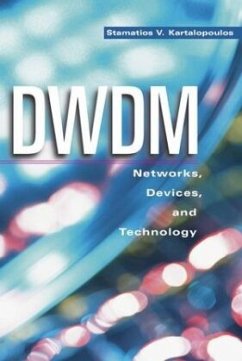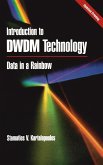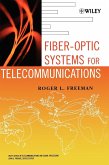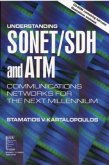- Gebundenes Buch
- Merkliste
- Auf die Merkliste
- Bewerten Bewerten
- Teilen
- Produkt teilen
- Produkterinnerung
- Produkterinnerung
_ DWDM (Dense Wavelength Division Multiplexing) is the technology that allows multiple streams of data to flow on today's optical fiber communication networks _ Comprehensive introduction to optical fiber communications covering the basic scientific principles _ Includes coverage of optical and photonic physics, as well as the new optical systems, devices, and networks that are replacing traditional electronics A Wiley-IEEE Press Publication
Andere Kunden interessierten sich auch für
![Introduction to Dwdm Technology Introduction to Dwdm Technology]() Stamatios V. KartalopoulosIntroduction to Dwdm Technology145,99 €
Stamatios V. KartalopoulosIntroduction to Dwdm Technology145,99 €![Fault Detectability in Dwdm Fault Detectability in Dwdm]() Stamatios V. KartalopoulosFault Detectability in Dwdm142,99 €
Stamatios V. KartalopoulosFault Detectability in Dwdm142,99 €![Fiber-Optic Systems for Telecommunications Fiber-Optic Systems for Telecommunications]() Roger L. FreemanFiber-Optic Systems for Telecommunications198,99 €
Roger L. FreemanFiber-Optic Systems for Telecommunications198,99 €![Advanced Quantum Communications Advanced Quantum Communications]() Sandor ImreAdvanced Quantum Communications176,99 €
Sandor ImreAdvanced Quantum Communications176,99 €![Introduction to Optical Waveguide Analysis Introduction to Optical Waveguide Analysis]() Kenji KawanoIntroduction to Optical Waveguide Analysis185,99 €
Kenji KawanoIntroduction to Optical Waveguide Analysis185,99 €![Understanding SONET / SDH and ATM Understanding SONET / SDH and ATM]() Stamatios V. KartalopoulosUnderstanding SONET / SDH and ATM128,99 €
Stamatios V. KartalopoulosUnderstanding SONET / SDH and ATM128,99 €![Quantum Networking Quantum Networking]() Rodney van MeterQuantum Networking187,99 €
Rodney van MeterQuantum Networking187,99 €-
-
-
_ DWDM (Dense Wavelength Division Multiplexing) is the technology that allows multiple streams of data to flow on today's optical fiber communication networks
_ Comprehensive introduction to optical fiber communications covering the basic scientific principles
_ Includes coverage of optical and photonic physics, as well as the new optical systems, devices, and networks that are replacing traditional electronics
A Wiley-IEEE Press Publication
_ Comprehensive introduction to optical fiber communications covering the basic scientific principles
_ Includes coverage of optical and photonic physics, as well as the new optical systems, devices, and networks that are replacing traditional electronics
A Wiley-IEEE Press Publication
Produktdetails
- Produktdetails
- Verlag: Wiley & Sons
- 1. Auflage
- Seitenzahl: 520
- Erscheinungstermin: 9. Oktober 2002
- Englisch
- Abmessung: 265mm x 175mm x 27mm
- Gewicht: 1417g
- ISBN-13: 9780471269052
- ISBN-10: 0471269050
- Artikelnr.: 14910431
- Herstellerkennzeichnung
- Libri GmbH
- Europaallee 1
- 36244 Bad Hersfeld
- gpsr@libri.de
- Verlag: Wiley & Sons
- 1. Auflage
- Seitenzahl: 520
- Erscheinungstermin: 9. Oktober 2002
- Englisch
- Abmessung: 265mm x 175mm x 27mm
- Gewicht: 1417g
- ISBN-13: 9780471269052
- ISBN-10: 0471269050
- Artikelnr.: 14910431
- Herstellerkennzeichnung
- Libri GmbH
- Europaallee 1
- 36244 Bad Hersfeld
- gpsr@libri.de
STAMATIOS V. KARTALOPOULOS, PhD, is currently the Williams Professor in Telecommunications Networking in the Telecommunications graduate program of the University of Oklahoma, Tulsa. Previously, he enjoyed a twenty-two-year tenure with such telecom giants as Bell Labs, Lucent Technologies, and AT&T. Dr. Kartalopoulos's previous optical networking texts include Understanding SONET/SDH and ATM: Communications Networks for the Next Millennium, Introduction to DWDM Technology: Data in a Rainbow, Fault Detectability in DWDM: Toward Higher Signal Quality and System Reliability, and DWDM: Networks, Devices, and Technology, all published by Wiley-IEEE Press.
Preface.
Acknowledgments.
List of Physical Constants.
Introduction.
1. The Physics of Optical Components.
1.1. Introduction.
1.2. The Nature of Light.
1.2.1. The Wave Nature of Light.
1.2.2. The Particle Nature of Light.
1.2.3. Huygens-Fresnel Principle.
1.2.4. Interference.
1.2.5. Holography.
1.2.6. Optical Correlators and Storage.
1.2.7. Light Attributes.
1.3. Optical Materials.
1.3.1. Transparent Versus Opaque Matter.
1.3.2. Homogeneity and Heterogeneity.
1.3.3. Isotropy and Anisotropy.
1.3.4. Organic Materials.
1.3.5. Photochromaticity.
1.4. Light Meets Matter.
1.4.1. Reflection and Refraction: Snell's Law.
1.4.2. Critical Angle.
1.4.3. Antireflection.
1.4.4. Prisms and Superprisms.
1.4.5. Propagation of Light.
1.4.6. Diffraction.
1.4.7. Polarization.
1.4.8. Extinction Ratio.
1.4.9. Phase Shift.
1.4.10. Birefringence.
1.4.11. Material Dispersion.
1.4.12. Electro-Optic Effects.
1.4.13. Material Attributes.
1.5. The Fiber as an Optical Transmission Medium.
1.5.1. Composite Refractive Indices.
1.5.2. Fiber Modes.
1.5.3. Fiber Attenuation and Power Loss.
1.5.4. Fiber Birefringence.
1.5.5. Dispersion.
1.5.6. Spectral Broadening.
1.5.7. Self-Phase Modulation.
1.5.8. Self-Modulation or Modulation Instability.
1.5.9. Effect of Pulse Broadening on Bit Error Rate.
1.6. Nonlinear Phenomena.
1.6.1. Stimulated Raman Scattering.
1.6.2. Stimulated Brillouin Scattering.
1.6.3. Four-Wave Mixing.
1.6.4. Temporal FWM, Near-End and Far-End.
1.6.5. Impact of FWM on DWDM Transmission Systems.
1.6.6. Countermeasures to Reduce FWM.
1.7. Solitons.
1.8. Summary of Nonlinear Phenomena.
1.9. Factors that Affect Matter and Light.
1.10. Regarding Optical Fiber.
1.10.1. Ideal Fiber Versus Real Fiber.
1.10.2. The Evolving Bandwidth-Span Product.
1.10.3. Fiber Amplifiers and Spectral Continuum.
1.10.4. New Fibers.
1.10.5. How Strong Is Fiber?
1.11. Fiber Connectivity.
1.12. Optical PWBs.
Exercises.
References.
Standards.
2. Optical Components.
2.1. Introduction.
2.1.1. Geometrical Optics.
2.1.2. Insertion Loss and Isolation.
2.1.3. Parameters Common to All Components.
2.2. Optical Filters.
2.2.1. Fabry-Perot Interferometer.
2.2.2. Dielectric Thin Film.
2.2.3. Diffraction Gratings.
2.2.4. Bragg Gratings.
2.2.5. Mach-Zehnder Interferometry.
2.2.6. Arrayed Waveguide Grating Filters.
2.2.7. Polarizing Filters.
2.2.8. Absorption Filters.
2.2.9. Acousto-Optic Tunable Filters.
2.2.10. Hybrid Filters.
2.2.11. Comparing Tunable Filters.
2.3. Optical Directional Couplers.
2.4. Optical Power Attenuators.
2.5. Polarizers and Rotators.
2.6. Beam Splitters.
2.7. Optical Isolators and Circulators.
2.8. Quarter-Wavelength and Half-Wavelength Plates.
2.9. Optical Multiplexers and Demultiplexers.
2.9.1. Prisms and Superprisms.
2.9.2. Gratings.
2.9.3. Mach-Zehnder Demultiplexer.
2.9.4. Arrayed Waveguide Grating Demultiplexers.
2.9.5. Channel Interleavers and Channel Splitters.
2.10. Optical Cross-Connects.
2.10.1. Free-Space Optical Switching.
2.10.2. Solid-State Cross-Connects.
2.10.3. Polymers and Inks.
2.10.4. Photochromic Materials.
2.10.5. Technologies and Switching Speeds.
2.11. Optical Add-Drop Multiplexers.
2.12. Optical Equalizers.
2.13. Light Sources.
2.13.1. Light-Emitting Diodes.
2.13.2. Lasers.
2.14. Laser Beams.
2.14.1. Gaussian Beams.
2.14.2. Near-Field and Far-Field Distribution.
2.14.3. Peak Wavelength.
2.14.4. Degree of Coherence.
2.14.5. Laser Safety.
2.15. Modulators.
2.15.1. Types of Modulators.
2.15.2. A Case: Amplitude Modulation.
2.15.3. Modulation and Bit Error Probabilities.
2.16. Photodetectors and Receivers.
2.16.1. The PIN Photodiode.
2.16.2. The APD Photodiode.
2.16.3. Photodetector Figure of Merit.
2.16.4. ITU-T Nominal Center Frequencies.
2.17. Optical Amplifiers.
2.17.1. Semiconductor Optical Amplifiers.
2.17.2. Rare Earth-Doped Fiber Optical Amplifiers.
2.17.3. Optical Parametric Amplifiers.
2.17.4. Raman Amplifiers.
2.17.5. Synergistic Amplification.
2.17.6. Stimulated Brillouin Scattering.
2.17.7. Amplification in the Low-Loss Spectral Range.
2.18. Wavelength Converters.
2.18.1. Cross-Gain Modulation.
2.18.2. Cross-Phase Modulation.
2.18.3. Four-Wave Mixing.
2.18.4. Optical Frequency Shifting.
2.19. Optical Phase-Locked Loops.
2.20. Ring Resonators.
2.21. Optical Attenuators.
2.22. Optical Signal-to-Noise Ratio.
2.22.1. Bit Error Rate.
2.22.2. BER and Eye Diagram.
2.23. New Materials and Components.
2.23.1. Optical Materials.
2.23.2. Hollow Fibers.
2.23.3. Lasers and Receivers.
2.23.4. Optical Cross-Connects.
2.23.5. Optical Memories.
2.23.6. Optical Integration.
Exercises.
References.
Standards / 233
3. Communications Fundamentals.
3.1. Introduction.
3.2. Pulse Coded Modulation.
3.3. Loop Accessing Methods.
3.3.1. xDSL.
3.3.2. Other High-Speed Short-Reach Technologies.
3.4. Time Division Multiplexing Systems.
3.4.1. Access and Pair-Gain Systems.
3.4.2. Fiber-to-the-Home Technology.
3.4.3. Switching Systems.
3.4.4. Digital Cross-Connect Systems.
3.5. Getting Connected.
3.6. Data Systems.
3.6.1. The OSI Model.
3.6.2. Local Area Networks.
3.6.3. Packet Networks.
3.6.4. Frame Relay.
3.6.5. ATM.
3.6.6. Quality of Service.
3.7. SONET and SDH.
3.7.1. SONET Topologies.
3.7.2. SONET and SDH Rates.
3.7.3. SONET and SDH Frames.
3.7.4. Floating Frames and Pointers.
3.7.5. Overhead Definition.
3.7.6. Frequency Justification.
3.7.7. Path Overhead.
3.7.8. Maintenance.
3.7.9. Operations Communications Interface.
3.7.10. Interworking.
3.7.11. Next-Generation SONET.
3.8. Internet.
3.8.1. Voice over IP.
3.8.2. Fax over IP (FoIP).
3.8.3. ATM over SONET.
3.8.4. IP over SONET.
3.9. Optical Networks.
3.10. What Is a DWDM System and Network?
Exercises.
References.
Standards.
4 .DWDM Systems.
4.1. Introduction.
4.2. DWDM Network Topologies-Review.
4.3. DWDM Systems and Network Layers.
4.3.1. DWDM and Standards.
4.3.2. Domains or Functions.
4.3.3. System Partitioning and Remoting.
4.4. Key Building Blocks of a DWDM System.
4.4.1. Transmitters and Receivers.
4.4.2. Optical Amplifiers and Regenerators.
4.4.3. Dispersion Compensating Solutions.
4.4.4. Optical Gain Equalizers.
4.4.5. Optical Wavelength Translators.
4.4.6. Timing.
4.4.7. Optical Switching.
4.4.8. Control Architectures and Controllers.
4.4.9. Interfaces.
4.5. Wavelength Management Strategy.
4.6. Equipment Sensing Strategy.
4.7. Fault Detection and Reporting Strategy.
4.7.1. Fault Detection on the Network Level.
4.7.2. Fault Detection Identifiers.
4.7.3. Overhead, Data, and Error Correction: The Digital Wrapper.
4.8. Power Strategy.
4.9. DWDM Systems by Network Layer.
4.9.1. Point-to-Point Systems.
4.9.2. Large Optical Cross-Connect Systems.
4.9.3. DWDM Metro Systems.
4.9.4. Access DWDM Systems and First/Last Mile.
4.10. Protected and Unprotected Systems.
4.11. Engineering DWDM Systems.
4.11.1. Parameters That Influence Optical Design.
4.11.2. ITU-T Recommended Frequencies.
4.11.3. Channel Capacity, Width, and Spacing.
4.11.4. Channel Bit Rate and Modulation.
4.11.5. Multichannel Frequency Stabilization.
4.11.6. BER and Channel Performance.
4.11.7. Channel Dispersion.
4.11.8. Power Launched.
4.11.9. Optical Amplification and Compensation.
4.11.10. The Fiber-Medium and Limitations.
4.11.11. Optical Power Budget.
4.11.12. Power Budget Calculations by Example.
Conclusions.
Exercises.
References.
Standards.
5. DWDM Networks.
5.1. Introduction.
5.1.1. Multiprotocol Label Switching.
5.1.2. MP¿S.
5.1.3. DiffServ, IntServ, and MPLS.
5.1.4. Optical Virtual Path Network.
5.1.5. Network Layers and Protection.
5.1.6. The Evolving Telecommunications Management Network.
5.2. The Optical Transport Network.
5.3. DWDM Network Topologies and Restoration Strategies.
5.3.1. Point-to-Point Topology.
5.3.2. Ring Topology.
5.3.3. Mesh Topology.
5.3.4. Ring-Mesh Networks.
5.4. Dispersion Management.
5.5. Bandwidth Management.
5.5.1. Wavelength Management.
5.5.2. Traffic Management.
5.5.3. Congestion Management.
5.6. Fiber Span Between Transmitter and Receiver.
5.7. Fault Management.
5.8. Network Security.
5.9. DWDM Network Issues.
5.9.1. Interoperability and Internetworking.
5.9.2. Optical Performance Monitoring.
5.9.3. Network Future-Proofing.
5.9.4. Wavelength Sharing.
5.9.5. IP/SONET over DWDM.
5.9.6. Maintenance.
5.9.7. DWDM Network Management.
5.10. Wireless DWDM Networks.
Exercises.
References.
Standards.
6. Emerging Technologies.
6.1. Introduction.
6.2. Emerging Technologies.
6.2.1. Theory and New Materials.
6.2.2. Communications Components, Systems, and Networks.
6.2.3. Intelligent Homes.
6.2.4. Intelligent Transportation.
6.2.5. Intelligent Powering Systems.
6.3. Current Research.
6.3.1. Advanced Lasers.
6.3.2. Artificial Optical Materials.
6.3.3. Optical Cross-Connect.
6.3.4. Optical Memories and Variable Delay Lines.
6.3.5. Nonintrusive Optical Sensors.
6.4. Conclusion.
References.
Standards.
Answers to Exercises.
Acronyms.
Index.
About the Author.
Acknowledgments.
List of Physical Constants.
Introduction.
1. The Physics of Optical Components.
1.1. Introduction.
1.2. The Nature of Light.
1.2.1. The Wave Nature of Light.
1.2.2. The Particle Nature of Light.
1.2.3. Huygens-Fresnel Principle.
1.2.4. Interference.
1.2.5. Holography.
1.2.6. Optical Correlators and Storage.
1.2.7. Light Attributes.
1.3. Optical Materials.
1.3.1. Transparent Versus Opaque Matter.
1.3.2. Homogeneity and Heterogeneity.
1.3.3. Isotropy and Anisotropy.
1.3.4. Organic Materials.
1.3.5. Photochromaticity.
1.4. Light Meets Matter.
1.4.1. Reflection and Refraction: Snell's Law.
1.4.2. Critical Angle.
1.4.3. Antireflection.
1.4.4. Prisms and Superprisms.
1.4.5. Propagation of Light.
1.4.6. Diffraction.
1.4.7. Polarization.
1.4.8. Extinction Ratio.
1.4.9. Phase Shift.
1.4.10. Birefringence.
1.4.11. Material Dispersion.
1.4.12. Electro-Optic Effects.
1.4.13. Material Attributes.
1.5. The Fiber as an Optical Transmission Medium.
1.5.1. Composite Refractive Indices.
1.5.2. Fiber Modes.
1.5.3. Fiber Attenuation and Power Loss.
1.5.4. Fiber Birefringence.
1.5.5. Dispersion.
1.5.6. Spectral Broadening.
1.5.7. Self-Phase Modulation.
1.5.8. Self-Modulation or Modulation Instability.
1.5.9. Effect of Pulse Broadening on Bit Error Rate.
1.6. Nonlinear Phenomena.
1.6.1. Stimulated Raman Scattering.
1.6.2. Stimulated Brillouin Scattering.
1.6.3. Four-Wave Mixing.
1.6.4. Temporal FWM, Near-End and Far-End.
1.6.5. Impact of FWM on DWDM Transmission Systems.
1.6.6. Countermeasures to Reduce FWM.
1.7. Solitons.
1.8. Summary of Nonlinear Phenomena.
1.9. Factors that Affect Matter and Light.
1.10. Regarding Optical Fiber.
1.10.1. Ideal Fiber Versus Real Fiber.
1.10.2. The Evolving Bandwidth-Span Product.
1.10.3. Fiber Amplifiers and Spectral Continuum.
1.10.4. New Fibers.
1.10.5. How Strong Is Fiber?
1.11. Fiber Connectivity.
1.12. Optical PWBs.
Exercises.
References.
Standards.
2. Optical Components.
2.1. Introduction.
2.1.1. Geometrical Optics.
2.1.2. Insertion Loss and Isolation.
2.1.3. Parameters Common to All Components.
2.2. Optical Filters.
2.2.1. Fabry-Perot Interferometer.
2.2.2. Dielectric Thin Film.
2.2.3. Diffraction Gratings.
2.2.4. Bragg Gratings.
2.2.5. Mach-Zehnder Interferometry.
2.2.6. Arrayed Waveguide Grating Filters.
2.2.7. Polarizing Filters.
2.2.8. Absorption Filters.
2.2.9. Acousto-Optic Tunable Filters.
2.2.10. Hybrid Filters.
2.2.11. Comparing Tunable Filters.
2.3. Optical Directional Couplers.
2.4. Optical Power Attenuators.
2.5. Polarizers and Rotators.
2.6. Beam Splitters.
2.7. Optical Isolators and Circulators.
2.8. Quarter-Wavelength and Half-Wavelength Plates.
2.9. Optical Multiplexers and Demultiplexers.
2.9.1. Prisms and Superprisms.
2.9.2. Gratings.
2.9.3. Mach-Zehnder Demultiplexer.
2.9.4. Arrayed Waveguide Grating Demultiplexers.
2.9.5. Channel Interleavers and Channel Splitters.
2.10. Optical Cross-Connects.
2.10.1. Free-Space Optical Switching.
2.10.2. Solid-State Cross-Connects.
2.10.3. Polymers and Inks.
2.10.4. Photochromic Materials.
2.10.5. Technologies and Switching Speeds.
2.11. Optical Add-Drop Multiplexers.
2.12. Optical Equalizers.
2.13. Light Sources.
2.13.1. Light-Emitting Diodes.
2.13.2. Lasers.
2.14. Laser Beams.
2.14.1. Gaussian Beams.
2.14.2. Near-Field and Far-Field Distribution.
2.14.3. Peak Wavelength.
2.14.4. Degree of Coherence.
2.14.5. Laser Safety.
2.15. Modulators.
2.15.1. Types of Modulators.
2.15.2. A Case: Amplitude Modulation.
2.15.3. Modulation and Bit Error Probabilities.
2.16. Photodetectors and Receivers.
2.16.1. The PIN Photodiode.
2.16.2. The APD Photodiode.
2.16.3. Photodetector Figure of Merit.
2.16.4. ITU-T Nominal Center Frequencies.
2.17. Optical Amplifiers.
2.17.1. Semiconductor Optical Amplifiers.
2.17.2. Rare Earth-Doped Fiber Optical Amplifiers.
2.17.3. Optical Parametric Amplifiers.
2.17.4. Raman Amplifiers.
2.17.5. Synergistic Amplification.
2.17.6. Stimulated Brillouin Scattering.
2.17.7. Amplification in the Low-Loss Spectral Range.
2.18. Wavelength Converters.
2.18.1. Cross-Gain Modulation.
2.18.2. Cross-Phase Modulation.
2.18.3. Four-Wave Mixing.
2.18.4. Optical Frequency Shifting.
2.19. Optical Phase-Locked Loops.
2.20. Ring Resonators.
2.21. Optical Attenuators.
2.22. Optical Signal-to-Noise Ratio.
2.22.1. Bit Error Rate.
2.22.2. BER and Eye Diagram.
2.23. New Materials and Components.
2.23.1. Optical Materials.
2.23.2. Hollow Fibers.
2.23.3. Lasers and Receivers.
2.23.4. Optical Cross-Connects.
2.23.5. Optical Memories.
2.23.6. Optical Integration.
Exercises.
References.
Standards / 233
3. Communications Fundamentals.
3.1. Introduction.
3.2. Pulse Coded Modulation.
3.3. Loop Accessing Methods.
3.3.1. xDSL.
3.3.2. Other High-Speed Short-Reach Technologies.
3.4. Time Division Multiplexing Systems.
3.4.1. Access and Pair-Gain Systems.
3.4.2. Fiber-to-the-Home Technology.
3.4.3. Switching Systems.
3.4.4. Digital Cross-Connect Systems.
3.5. Getting Connected.
3.6. Data Systems.
3.6.1. The OSI Model.
3.6.2. Local Area Networks.
3.6.3. Packet Networks.
3.6.4. Frame Relay.
3.6.5. ATM.
3.6.6. Quality of Service.
3.7. SONET and SDH.
3.7.1. SONET Topologies.
3.7.2. SONET and SDH Rates.
3.7.3. SONET and SDH Frames.
3.7.4. Floating Frames and Pointers.
3.7.5. Overhead Definition.
3.7.6. Frequency Justification.
3.7.7. Path Overhead.
3.7.8. Maintenance.
3.7.9. Operations Communications Interface.
3.7.10. Interworking.
3.7.11. Next-Generation SONET.
3.8. Internet.
3.8.1. Voice over IP.
3.8.2. Fax over IP (FoIP).
3.8.3. ATM over SONET.
3.8.4. IP over SONET.
3.9. Optical Networks.
3.10. What Is a DWDM System and Network?
Exercises.
References.
Standards.
4 .DWDM Systems.
4.1. Introduction.
4.2. DWDM Network Topologies-Review.
4.3. DWDM Systems and Network Layers.
4.3.1. DWDM and Standards.
4.3.2. Domains or Functions.
4.3.3. System Partitioning and Remoting.
4.4. Key Building Blocks of a DWDM System.
4.4.1. Transmitters and Receivers.
4.4.2. Optical Amplifiers and Regenerators.
4.4.3. Dispersion Compensating Solutions.
4.4.4. Optical Gain Equalizers.
4.4.5. Optical Wavelength Translators.
4.4.6. Timing.
4.4.7. Optical Switching.
4.4.8. Control Architectures and Controllers.
4.4.9. Interfaces.
4.5. Wavelength Management Strategy.
4.6. Equipment Sensing Strategy.
4.7. Fault Detection and Reporting Strategy.
4.7.1. Fault Detection on the Network Level.
4.7.2. Fault Detection Identifiers.
4.7.3. Overhead, Data, and Error Correction: The Digital Wrapper.
4.8. Power Strategy.
4.9. DWDM Systems by Network Layer.
4.9.1. Point-to-Point Systems.
4.9.2. Large Optical Cross-Connect Systems.
4.9.3. DWDM Metro Systems.
4.9.4. Access DWDM Systems and First/Last Mile.
4.10. Protected and Unprotected Systems.
4.11. Engineering DWDM Systems.
4.11.1. Parameters That Influence Optical Design.
4.11.2. ITU-T Recommended Frequencies.
4.11.3. Channel Capacity, Width, and Spacing.
4.11.4. Channel Bit Rate and Modulation.
4.11.5. Multichannel Frequency Stabilization.
4.11.6. BER and Channel Performance.
4.11.7. Channel Dispersion.
4.11.8. Power Launched.
4.11.9. Optical Amplification and Compensation.
4.11.10. The Fiber-Medium and Limitations.
4.11.11. Optical Power Budget.
4.11.12. Power Budget Calculations by Example.
Conclusions.
Exercises.
References.
Standards.
5. DWDM Networks.
5.1. Introduction.
5.1.1. Multiprotocol Label Switching.
5.1.2. MP¿S.
5.1.3. DiffServ, IntServ, and MPLS.
5.1.4. Optical Virtual Path Network.
5.1.5. Network Layers and Protection.
5.1.6. The Evolving Telecommunications Management Network.
5.2. The Optical Transport Network.
5.3. DWDM Network Topologies and Restoration Strategies.
5.3.1. Point-to-Point Topology.
5.3.2. Ring Topology.
5.3.3. Mesh Topology.
5.3.4. Ring-Mesh Networks.
5.4. Dispersion Management.
5.5. Bandwidth Management.
5.5.1. Wavelength Management.
5.5.2. Traffic Management.
5.5.3. Congestion Management.
5.6. Fiber Span Between Transmitter and Receiver.
5.7. Fault Management.
5.8. Network Security.
5.9. DWDM Network Issues.
5.9.1. Interoperability and Internetworking.
5.9.2. Optical Performance Monitoring.
5.9.3. Network Future-Proofing.
5.9.4. Wavelength Sharing.
5.9.5. IP/SONET over DWDM.
5.9.6. Maintenance.
5.9.7. DWDM Network Management.
5.10. Wireless DWDM Networks.
Exercises.
References.
Standards.
6. Emerging Technologies.
6.1. Introduction.
6.2. Emerging Technologies.
6.2.1. Theory and New Materials.
6.2.2. Communications Components, Systems, and Networks.
6.2.3. Intelligent Homes.
6.2.4. Intelligent Transportation.
6.2.5. Intelligent Powering Systems.
6.3. Current Research.
6.3.1. Advanced Lasers.
6.3.2. Artificial Optical Materials.
6.3.3. Optical Cross-Connect.
6.3.4. Optical Memories and Variable Delay Lines.
6.3.5. Nonintrusive Optical Sensors.
6.4. Conclusion.
References.
Standards.
Answers to Exercises.
Acronyms.
Index.
About the Author.
Preface.
Acknowledgments.
List of Physical Constants.
Introduction.
1. The Physics of Optical Components.
1.1. Introduction.
1.2. The Nature of Light.
1.2.1. The Wave Nature of Light.
1.2.2. The Particle Nature of Light.
1.2.3. Huygens-Fresnel Principle.
1.2.4. Interference.
1.2.5. Holography.
1.2.6. Optical Correlators and Storage.
1.2.7. Light Attributes.
1.3. Optical Materials.
1.3.1. Transparent Versus Opaque Matter.
1.3.2. Homogeneity and Heterogeneity.
1.3.3. Isotropy and Anisotropy.
1.3.4. Organic Materials.
1.3.5. Photochromaticity.
1.4. Light Meets Matter.
1.4.1. Reflection and Refraction: Snell's Law.
1.4.2. Critical Angle.
1.4.3. Antireflection.
1.4.4. Prisms and Superprisms.
1.4.5. Propagation of Light.
1.4.6. Diffraction.
1.4.7. Polarization.
1.4.8. Extinction Ratio.
1.4.9. Phase Shift.
1.4.10. Birefringence.
1.4.11. Material Dispersion.
1.4.12. Electro-Optic Effects.
1.4.13. Material Attributes.
1.5. The Fiber as an Optical Transmission Medium.
1.5.1. Composite Refractive Indices.
1.5.2. Fiber Modes.
1.5.3. Fiber Attenuation and Power Loss.
1.5.4. Fiber Birefringence.
1.5.5. Dispersion.
1.5.6. Spectral Broadening.
1.5.7. Self-Phase Modulation.
1.5.8. Self-Modulation or Modulation Instability.
1.5.9. Effect of Pulse Broadening on Bit Error Rate.
1.6. Nonlinear Phenomena.
1.6.1. Stimulated Raman Scattering.
1.6.2. Stimulated Brillouin Scattering.
1.6.3. Four-Wave Mixing.
1.6.4. Temporal FWM, Near-End and Far-End.
1.6.5. Impact of FWM on DWDM Transmission Systems.
1.6.6. Countermeasures to Reduce FWM.
1.7. Solitons.
1.8. Summary of Nonlinear Phenomena.
1.9. Factors that Affect Matter and Light.
1.10. Regarding Optical Fiber.
1.10.1. Ideal Fiber Versus Real Fiber.
1.10.2. The Evolving Bandwidth-Span Product.
1.10.3. Fiber Amplifiers and Spectral Continuum.
1.10.4. New Fibers.
1.10.5. How Strong Is Fiber?
1.11. Fiber Connectivity.
1.12. Optical PWBs.
Exercises.
References.
Standards.
2. Optical Components.
2.1. Introduction.
2.1.1. Geometrical Optics.
2.1.2. Insertion Loss and Isolation.
2.1.3. Parameters Common to All Components.
2.2. Optical Filters.
2.2.1. Fabry-Perot Interferometer.
2.2.2. Dielectric Thin Film.
2.2.3. Diffraction Gratings.
2.2.4. Bragg Gratings.
2.2.5. Mach-Zehnder Interferometry.
2.2.6. Arrayed Waveguide Grating Filters.
2.2.7. Polarizing Filters.
2.2.8. Absorption Filters.
2.2.9. Acousto-Optic Tunable Filters.
2.2.10. Hybrid Filters.
2.2.11. Comparing Tunable Filters.
2.3. Optical Directional Couplers.
2.4. Optical Power Attenuators.
2.5. Polarizers and Rotators.
2.6. Beam Splitters.
2.7. Optical Isolators and Circulators.
2.8. Quarter-Wavelength and Half-Wavelength Plates.
2.9. Optical Multiplexers and Demultiplexers.
2.9.1. Prisms and Superprisms.
2.9.2. Gratings.
2.9.3. Mach-Zehnder Demultiplexer.
2.9.4. Arrayed Waveguide Grating Demultiplexers.
2.9.5. Channel Interleavers and Channel Splitters.
2.10. Optical Cross-Connects.
2.10.1. Free-Space Optical Switching.
2.10.2. Solid-State Cross-Connects.
2.10.3. Polymers and Inks.
2.10.4. Photochromic Materials.
2.10.5. Technologies and Switching Speeds.
2.11. Optical Add-Drop Multiplexers.
2.12. Optical Equalizers.
2.13. Light Sources.
2.13.1. Light-Emitting Diodes.
2.13.2. Lasers.
2.14. Laser Beams.
2.14.1. Gaussian Beams.
2.14.2. Near-Field and Far-Field Distribution.
2.14.3. Peak Wavelength.
2.14.4. Degree of Coherence.
2.14.5. Laser Safety.
2.15. Modulators.
2.15.1. Types of Modulators.
2.15.2. A Case: Amplitude Modulation.
2.15.3. Modulation and Bit Error Probabilities.
2.16. Photodetectors and Receivers.
2.16.1. The PIN Photodiode.
2.16.2. The APD Photodiode.
2.16.3. Photodetector Figure of Merit.
2.16.4. ITU-T Nominal Center Frequencies.
2.17. Optical Amplifiers.
2.17.1. Semiconductor Optical Amplifiers.
2.17.2. Rare Earth-Doped Fiber Optical Amplifiers.
2.17.3. Optical Parametric Amplifiers.
2.17.4. Raman Amplifiers.
2.17.5. Synergistic Amplification.
2.17.6. Stimulated Brillouin Scattering.
2.17.7. Amplification in the Low-Loss Spectral Range.
2.18. Wavelength Converters.
2.18.1. Cross-Gain Modulation.
2.18.2. Cross-Phase Modulation.
2.18.3. Four-Wave Mixing.
2.18.4. Optical Frequency Shifting.
2.19. Optical Phase-Locked Loops.
2.20. Ring Resonators.
2.21. Optical Attenuators.
2.22. Optical Signal-to-Noise Ratio.
2.22.1. Bit Error Rate.
2.22.2. BER and Eye Diagram.
2.23. New Materials and Components.
2.23.1. Optical Materials.
2.23.2. Hollow Fibers.
2.23.3. Lasers and Receivers.
2.23.4. Optical Cross-Connects.
2.23.5. Optical Memories.
2.23.6. Optical Integration.
Exercises.
References.
Standards / 233
3. Communications Fundamentals.
3.1. Introduction.
3.2. Pulse Coded Modulation.
3.3. Loop Accessing Methods.
3.3.1. xDSL.
3.3.2. Other High-Speed Short-Reach Technologies.
3.4. Time Division Multiplexing Systems.
3.4.1. Access and Pair-Gain Systems.
3.4.2. Fiber-to-the-Home Technology.
3.4.3. Switching Systems.
3.4.4. Digital Cross-Connect Systems.
3.5. Getting Connected.
3.6. Data Systems.
3.6.1. The OSI Model.
3.6.2. Local Area Networks.
3.6.3. Packet Networks.
3.6.4. Frame Relay.
3.6.5. ATM.
3.6.6. Quality of Service.
3.7. SONET and SDH.
3.7.1. SONET Topologies.
3.7.2. SONET and SDH Rates.
3.7.3. SONET and SDH Frames.
3.7.4. Floating Frames and Pointers.
3.7.5. Overhead Definition.
3.7.6. Frequency Justification.
3.7.7. Path Overhead.
3.7.8. Maintenance.
3.7.9. Operations Communications Interface.
3.7.10. Interworking.
3.7.11. Next-Generation SONET.
3.8. Internet.
3.8.1. Voice over IP.
3.8.2. Fax over IP (FoIP).
3.8.3. ATM over SONET.
3.8.4. IP over SONET.
3.9. Optical Networks.
3.10. What Is a DWDM System and Network?
Exercises.
References.
Standards.
4 .DWDM Systems.
4.1. Introduction.
4.2. DWDM Network Topologies-Review.
4.3. DWDM Systems and Network Layers.
4.3.1. DWDM and Standards.
4.3.2. Domains or Functions.
4.3.3. System Partitioning and Remoting.
4.4. Key Building Blocks of a DWDM System.
4.4.1. Transmitters and Receivers.
4.4.2. Optical Amplifiers and Regenerators.
4.4.3. Dispersion Compensating Solutions.
4.4.4. Optical Gain Equalizers.
4.4.5. Optical Wavelength Translators.
4.4.6. Timing.
4.4.7. Optical Switching.
4.4.8. Control Architectures and Controllers.
4.4.9. Interfaces.
4.5. Wavelength Management Strategy.
4.6. Equipment Sensing Strategy.
4.7. Fault Detection and Reporting Strategy.
4.7.1. Fault Detection on the Network Level.
4.7.2. Fault Detection Identifiers.
4.7.3. Overhead, Data, and Error Correction: The Digital Wrapper.
4.8. Power Strategy.
4.9. DWDM Systems by Network Layer.
4.9.1. Point-to-Point Systems.
4.9.2. Large Optical Cross-Connect Systems.
4.9.3. DWDM Metro Systems.
4.9.4. Access DWDM Systems and First/Last Mile.
4.10. Protected and Unprotected Systems.
4.11. Engineering DWDM Systems.
4.11.1. Parameters That Influence Optical Design.
4.11.2. ITU-T Recommended Frequencies.
4.11.3. Channel Capacity, Width, and Spacing.
4.11.4. Channel Bit Rate and Modulation.
4.11.5. Multichannel Frequency Stabilization.
4.11.6. BER and Channel Performance.
4.11.7. Channel Dispersion.
4.11.8. Power Launched.
4.11.9. Optical Amplification and Compensation.
4.11.10. The Fiber-Medium and Limitations.
4.11.11. Optical Power Budget.
4.11.12. Power Budget Calculations by Example.
Conclusions.
Exercises.
References.
Standards.
5. DWDM Networks.
5.1. Introduction.
5.1.1. Multiprotocol Label Switching.
5.1.2. MP¿S.
5.1.3. DiffServ, IntServ, and MPLS.
5.1.4. Optical Virtual Path Network.
5.1.5. Network Layers and Protection.
5.1.6. The Evolving Telecommunications Management Network.
5.2. The Optical Transport Network.
5.3. DWDM Network Topologies and Restoration Strategies.
5.3.1. Point-to-Point Topology.
5.3.2. Ring Topology.
5.3.3. Mesh Topology.
5.3.4. Ring-Mesh Networks.
5.4. Dispersion Management.
5.5. Bandwidth Management.
5.5.1. Wavelength Management.
5.5.2. Traffic Management.
5.5.3. Congestion Management.
5.6. Fiber Span Between Transmitter and Receiver.
5.7. Fault Management.
5.8. Network Security.
5.9. DWDM Network Issues.
5.9.1. Interoperability and Internetworking.
5.9.2. Optical Performance Monitoring.
5.9.3. Network Future-Proofing.
5.9.4. Wavelength Sharing.
5.9.5. IP/SONET over DWDM.
5.9.6. Maintenance.
5.9.7. DWDM Network Management.
5.10. Wireless DWDM Networks.
Exercises.
References.
Standards.
6. Emerging Technologies.
6.1. Introduction.
6.2. Emerging Technologies.
6.2.1. Theory and New Materials.
6.2.2. Communications Components, Systems, and Networks.
6.2.3. Intelligent Homes.
6.2.4. Intelligent Transportation.
6.2.5. Intelligent Powering Systems.
6.3. Current Research.
6.3.1. Advanced Lasers.
6.3.2. Artificial Optical Materials.
6.3.3. Optical Cross-Connect.
6.3.4. Optical Memories and Variable Delay Lines.
6.3.5. Nonintrusive Optical Sensors.
6.4. Conclusion.
References.
Standards.
Answers to Exercises.
Acronyms.
Index.
About the Author.
Acknowledgments.
List of Physical Constants.
Introduction.
1. The Physics of Optical Components.
1.1. Introduction.
1.2. The Nature of Light.
1.2.1. The Wave Nature of Light.
1.2.2. The Particle Nature of Light.
1.2.3. Huygens-Fresnel Principle.
1.2.4. Interference.
1.2.5. Holography.
1.2.6. Optical Correlators and Storage.
1.2.7. Light Attributes.
1.3. Optical Materials.
1.3.1. Transparent Versus Opaque Matter.
1.3.2. Homogeneity and Heterogeneity.
1.3.3. Isotropy and Anisotropy.
1.3.4. Organic Materials.
1.3.5. Photochromaticity.
1.4. Light Meets Matter.
1.4.1. Reflection and Refraction: Snell's Law.
1.4.2. Critical Angle.
1.4.3. Antireflection.
1.4.4. Prisms and Superprisms.
1.4.5. Propagation of Light.
1.4.6. Diffraction.
1.4.7. Polarization.
1.4.8. Extinction Ratio.
1.4.9. Phase Shift.
1.4.10. Birefringence.
1.4.11. Material Dispersion.
1.4.12. Electro-Optic Effects.
1.4.13. Material Attributes.
1.5. The Fiber as an Optical Transmission Medium.
1.5.1. Composite Refractive Indices.
1.5.2. Fiber Modes.
1.5.3. Fiber Attenuation and Power Loss.
1.5.4. Fiber Birefringence.
1.5.5. Dispersion.
1.5.6. Spectral Broadening.
1.5.7. Self-Phase Modulation.
1.5.8. Self-Modulation or Modulation Instability.
1.5.9. Effect of Pulse Broadening on Bit Error Rate.
1.6. Nonlinear Phenomena.
1.6.1. Stimulated Raman Scattering.
1.6.2. Stimulated Brillouin Scattering.
1.6.3. Four-Wave Mixing.
1.6.4. Temporal FWM, Near-End and Far-End.
1.6.5. Impact of FWM on DWDM Transmission Systems.
1.6.6. Countermeasures to Reduce FWM.
1.7. Solitons.
1.8. Summary of Nonlinear Phenomena.
1.9. Factors that Affect Matter and Light.
1.10. Regarding Optical Fiber.
1.10.1. Ideal Fiber Versus Real Fiber.
1.10.2. The Evolving Bandwidth-Span Product.
1.10.3. Fiber Amplifiers and Spectral Continuum.
1.10.4. New Fibers.
1.10.5. How Strong Is Fiber?
1.11. Fiber Connectivity.
1.12. Optical PWBs.
Exercises.
References.
Standards.
2. Optical Components.
2.1. Introduction.
2.1.1. Geometrical Optics.
2.1.2. Insertion Loss and Isolation.
2.1.3. Parameters Common to All Components.
2.2. Optical Filters.
2.2.1. Fabry-Perot Interferometer.
2.2.2. Dielectric Thin Film.
2.2.3. Diffraction Gratings.
2.2.4. Bragg Gratings.
2.2.5. Mach-Zehnder Interferometry.
2.2.6. Arrayed Waveguide Grating Filters.
2.2.7. Polarizing Filters.
2.2.8. Absorption Filters.
2.2.9. Acousto-Optic Tunable Filters.
2.2.10. Hybrid Filters.
2.2.11. Comparing Tunable Filters.
2.3. Optical Directional Couplers.
2.4. Optical Power Attenuators.
2.5. Polarizers and Rotators.
2.6. Beam Splitters.
2.7. Optical Isolators and Circulators.
2.8. Quarter-Wavelength and Half-Wavelength Plates.
2.9. Optical Multiplexers and Demultiplexers.
2.9.1. Prisms and Superprisms.
2.9.2. Gratings.
2.9.3. Mach-Zehnder Demultiplexer.
2.9.4. Arrayed Waveguide Grating Demultiplexers.
2.9.5. Channel Interleavers and Channel Splitters.
2.10. Optical Cross-Connects.
2.10.1. Free-Space Optical Switching.
2.10.2. Solid-State Cross-Connects.
2.10.3. Polymers and Inks.
2.10.4. Photochromic Materials.
2.10.5. Technologies and Switching Speeds.
2.11. Optical Add-Drop Multiplexers.
2.12. Optical Equalizers.
2.13. Light Sources.
2.13.1. Light-Emitting Diodes.
2.13.2. Lasers.
2.14. Laser Beams.
2.14.1. Gaussian Beams.
2.14.2. Near-Field and Far-Field Distribution.
2.14.3. Peak Wavelength.
2.14.4. Degree of Coherence.
2.14.5. Laser Safety.
2.15. Modulators.
2.15.1. Types of Modulators.
2.15.2. A Case: Amplitude Modulation.
2.15.3. Modulation and Bit Error Probabilities.
2.16. Photodetectors and Receivers.
2.16.1. The PIN Photodiode.
2.16.2. The APD Photodiode.
2.16.3. Photodetector Figure of Merit.
2.16.4. ITU-T Nominal Center Frequencies.
2.17. Optical Amplifiers.
2.17.1. Semiconductor Optical Amplifiers.
2.17.2. Rare Earth-Doped Fiber Optical Amplifiers.
2.17.3. Optical Parametric Amplifiers.
2.17.4. Raman Amplifiers.
2.17.5. Synergistic Amplification.
2.17.6. Stimulated Brillouin Scattering.
2.17.7. Amplification in the Low-Loss Spectral Range.
2.18. Wavelength Converters.
2.18.1. Cross-Gain Modulation.
2.18.2. Cross-Phase Modulation.
2.18.3. Four-Wave Mixing.
2.18.4. Optical Frequency Shifting.
2.19. Optical Phase-Locked Loops.
2.20. Ring Resonators.
2.21. Optical Attenuators.
2.22. Optical Signal-to-Noise Ratio.
2.22.1. Bit Error Rate.
2.22.2. BER and Eye Diagram.
2.23. New Materials and Components.
2.23.1. Optical Materials.
2.23.2. Hollow Fibers.
2.23.3. Lasers and Receivers.
2.23.4. Optical Cross-Connects.
2.23.5. Optical Memories.
2.23.6. Optical Integration.
Exercises.
References.
Standards / 233
3. Communications Fundamentals.
3.1. Introduction.
3.2. Pulse Coded Modulation.
3.3. Loop Accessing Methods.
3.3.1. xDSL.
3.3.2. Other High-Speed Short-Reach Technologies.
3.4. Time Division Multiplexing Systems.
3.4.1. Access and Pair-Gain Systems.
3.4.2. Fiber-to-the-Home Technology.
3.4.3. Switching Systems.
3.4.4. Digital Cross-Connect Systems.
3.5. Getting Connected.
3.6. Data Systems.
3.6.1. The OSI Model.
3.6.2. Local Area Networks.
3.6.3. Packet Networks.
3.6.4. Frame Relay.
3.6.5. ATM.
3.6.6. Quality of Service.
3.7. SONET and SDH.
3.7.1. SONET Topologies.
3.7.2. SONET and SDH Rates.
3.7.3. SONET and SDH Frames.
3.7.4. Floating Frames and Pointers.
3.7.5. Overhead Definition.
3.7.6. Frequency Justification.
3.7.7. Path Overhead.
3.7.8. Maintenance.
3.7.9. Operations Communications Interface.
3.7.10. Interworking.
3.7.11. Next-Generation SONET.
3.8. Internet.
3.8.1. Voice over IP.
3.8.2. Fax over IP (FoIP).
3.8.3. ATM over SONET.
3.8.4. IP over SONET.
3.9. Optical Networks.
3.10. What Is a DWDM System and Network?
Exercises.
References.
Standards.
4 .DWDM Systems.
4.1. Introduction.
4.2. DWDM Network Topologies-Review.
4.3. DWDM Systems and Network Layers.
4.3.1. DWDM and Standards.
4.3.2. Domains or Functions.
4.3.3. System Partitioning and Remoting.
4.4. Key Building Blocks of a DWDM System.
4.4.1. Transmitters and Receivers.
4.4.2. Optical Amplifiers and Regenerators.
4.4.3. Dispersion Compensating Solutions.
4.4.4. Optical Gain Equalizers.
4.4.5. Optical Wavelength Translators.
4.4.6. Timing.
4.4.7. Optical Switching.
4.4.8. Control Architectures and Controllers.
4.4.9. Interfaces.
4.5. Wavelength Management Strategy.
4.6. Equipment Sensing Strategy.
4.7. Fault Detection and Reporting Strategy.
4.7.1. Fault Detection on the Network Level.
4.7.2. Fault Detection Identifiers.
4.7.3. Overhead, Data, and Error Correction: The Digital Wrapper.
4.8. Power Strategy.
4.9. DWDM Systems by Network Layer.
4.9.1. Point-to-Point Systems.
4.9.2. Large Optical Cross-Connect Systems.
4.9.3. DWDM Metro Systems.
4.9.4. Access DWDM Systems and First/Last Mile.
4.10. Protected and Unprotected Systems.
4.11. Engineering DWDM Systems.
4.11.1. Parameters That Influence Optical Design.
4.11.2. ITU-T Recommended Frequencies.
4.11.3. Channel Capacity, Width, and Spacing.
4.11.4. Channel Bit Rate and Modulation.
4.11.5. Multichannel Frequency Stabilization.
4.11.6. BER and Channel Performance.
4.11.7. Channel Dispersion.
4.11.8. Power Launched.
4.11.9. Optical Amplification and Compensation.
4.11.10. The Fiber-Medium and Limitations.
4.11.11. Optical Power Budget.
4.11.12. Power Budget Calculations by Example.
Conclusions.
Exercises.
References.
Standards.
5. DWDM Networks.
5.1. Introduction.
5.1.1. Multiprotocol Label Switching.
5.1.2. MP¿S.
5.1.3. DiffServ, IntServ, and MPLS.
5.1.4. Optical Virtual Path Network.
5.1.5. Network Layers and Protection.
5.1.6. The Evolving Telecommunications Management Network.
5.2. The Optical Transport Network.
5.3. DWDM Network Topologies and Restoration Strategies.
5.3.1. Point-to-Point Topology.
5.3.2. Ring Topology.
5.3.3. Mesh Topology.
5.3.4. Ring-Mesh Networks.
5.4. Dispersion Management.
5.5. Bandwidth Management.
5.5.1. Wavelength Management.
5.5.2. Traffic Management.
5.5.3. Congestion Management.
5.6. Fiber Span Between Transmitter and Receiver.
5.7. Fault Management.
5.8. Network Security.
5.9. DWDM Network Issues.
5.9.1. Interoperability and Internetworking.
5.9.2. Optical Performance Monitoring.
5.9.3. Network Future-Proofing.
5.9.4. Wavelength Sharing.
5.9.5. IP/SONET over DWDM.
5.9.6. Maintenance.
5.9.7. DWDM Network Management.
5.10. Wireless DWDM Networks.
Exercises.
References.
Standards.
6. Emerging Technologies.
6.1. Introduction.
6.2. Emerging Technologies.
6.2.1. Theory and New Materials.
6.2.2. Communications Components, Systems, and Networks.
6.2.3. Intelligent Homes.
6.2.4. Intelligent Transportation.
6.2.5. Intelligent Powering Systems.
6.3. Current Research.
6.3.1. Advanced Lasers.
6.3.2. Artificial Optical Materials.
6.3.3. Optical Cross-Connect.
6.3.4. Optical Memories and Variable Delay Lines.
6.3.5. Nonintrusive Optical Sensors.
6.4. Conclusion.
References.
Standards.
Answers to Exercises.
Acronyms.
Index.
About the Author.
"...very well-written and easy to read...contains invaluable resources for DWDM implementations for both beginners and advanced readers." ( IEEE Communications Magazine , September 2003)
"...an outstanding source of knowledge about optical systems...very well written and easy to read..." ( Comsoc.org , September 2003)
"...an outstanding source of knowledge about optical systems...very well written and easy to read..." ( Comsoc.org , September 2003)








